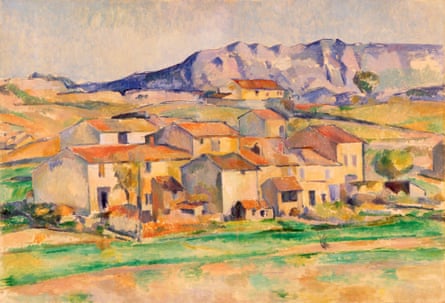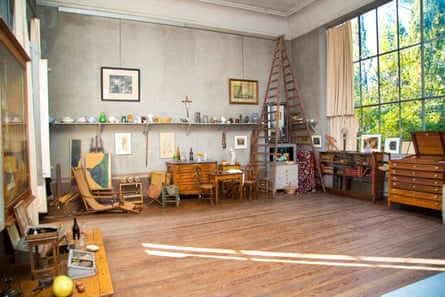Paul Cezanne is everywhere in Aix-en-Provence: there are streets named after him as well as a school, a cinema and even a sandwich (a version of traditional pan bagnat but with goat’s cheese instead of tuna). And from late June, the whole city will go Cezanne mad, as the painter’s atelier, north of the centre, and the family home to the west reopen after an eight-year restoration.
But during Cezanne’s lifetime, and for years after his death in 1906, Aix seemed at pains to ignore the artist later called the “father of modern art”. When his widow, Hortense, offered several paintings to the city’s main Musée Granet, director Henri Pontier declared that Cezanne paintings would enter the gallery only over his dead body.
This year, however (with Pontier dead almost a century), Aix is making up for its neglect with a blockbuster exhibition at Musée Granet to accompany the unveiling of Cezanne’s studio and the estate bought by the artist’s family in 1859. The retrospective will bring together more than 130 works, including still lifes, portraits and landscapes.
The paintings were all made in and around the Bastide du Jas de Bouffan, which was a refuge and inspiration for the painter for 40 years. Cezanne’s banker father acquired the 18th-century mansion with its farm and 15 hectares (37 acres) from a bankrupt client. Disappointed that his only son had no interest in finance, he still let young Paul use the ground floor grand salon as a workspace.


By 2017, however, the house had fallen into disrepair and was closed for a long renovation. Its grand opening is on 28 June, but we grab a sneak preview. Though now in an Aix suburb (20 minutes from the centre, or a few minutes on bus no 8), it’s a charming place, three serene storeys in five hectares of verdant grounds, its shutters painted in Aix’s signature grey-blue.
Inside, projections on the walls of the grand salon recreate the paintings (later chiselled off and sold) young Cezanne made on the walls, including a “four seasons” fresco. His card players series – one of which set a record in 2011 for the highest price ever paid for a work of art – was painted here, as was an 1866 portrait of Cezanne père reading a newspaper. (The artist and his family never used an accent on the first ‘e’ of their name: Cézanne seems to have been a later, Parisian invention.)
The family later made a studio for Paul on the second floor, and its tall window, higher than the roofline, can be seen from the front. The kitchen and Madame Cezanne’s bedroom can also be visited.
Daily guided tours of the interior (available in English) will cost from €9.50, but if these sell out, a ticket just for the grounds is still rewarding. For many fans, Cezanne’s genius lies in his outdoor works, and they come to life in the extensive gardens. There’s the chestnut avenue he painted, the farm buildings and, most evocative for me, the square bassin (pond) that features in dozens of pictures. I’m excited to spot the lion and dolphin statues seen in several canvases, the lions with their bums in the air. (The majestic plane trees and orangery were added by later owners.)
After his father died in 1886 and the estate was sold, Cezanne built his atelier in Les Lauves, then a rural area north of Aix, with views to the mountain that had long been his muse, Mont Sainte-Victoire. The 1,000-metre-high limestone ridge can be viewed from many points, including the roof terrace of our hotel, the Escaletto (doubles from €105) on the edge of the old town.

It’s a 15-minute walk from here to the atelier, up a road now called Avenue Paul Cézanne. The traditional-style house sits on rising ground, with kitchen and living areas on the ground floor; the first floor is one huge, high-ceilinged studio, with a full-height, north-facing window. This was his last workplace, where he painted the Bathers series, one of which is in London’s National Gallery. After further renovations next winter, the lower floor will have displays including the artist’s coat, palette and satchel.
If Aix had mixed feelings about its famous son, those seem to have been mutual. Of the 1,000-plus paintings Cezanne left, just one is of the city: a watercolour of the fountain in Place de la Mairie. However, he made hundreds in the countryside around, including over 80 of Mont Sainte-Victoire. So the best way to find Cezanne’s Provence is to get out of Aix.
Between the city and the mountain is Bibémus quarry, source of the creamy ochre stone that has built Aix since Roman times. The bus trip there (no 6) is like a ride through a thousand paintings. These wooded hills are all protected, and daily tickets (from the tourist office) include a shuttle from the terminus at Les Trois Bons Dieux. What pictures can’t convey is the loud birdsong, southern heat and early summer scents of pine and broom.
Cezanne made 27 paintings here, developing his pre-cubist style and trademark palette of blue, green and ochre. Reproductions of paintings around the quarry show the vantage point from which they were made – and their current homes: this one now in New York, others in San Francisco, Philadelphia, Baltimore …
after newsletter promotion
US tourists in Europe may not feel their homeland offers much to be proud of right now, but in Aix they can reflect with satisfaction that it was thanks to US collectors that Cezanne’s fame spread and his legacy was preserved. The atelier would have been demolished for housing had a group of US collectors not saved it in 1952. And an American artist, George Bunker, bought the Bibémus quarry in 1954 and left it to the city when he died in 1991, on condition that the land be protected and open to visitors.
Canadian sculptor David Campbell, now in his late 80s, with wizard-like white hair, was a friend of Bunker’s and has lived here in a quarryman’s cottage for 40 years. We spy him exercising on the edge of the site and he later shows us some of his fluid works in white limestone, plus masterly recreations of medieval masonry.
The Red Rock (c.1895, now in Paris’s Musée de l’Orangerie) is one of the best-known Cezanne quarry paintings, and the small post at the bottom left is still there today. But the site calls to my mind another in the National Gallery, with, unusually, a figure in white shirt and blue trousers dwarfed by a wall of orange rock.
Visitors can also book a 6pm visit to Bibémus to enjoy the setting sun on Mont Sainte-Victoire (€17pp) or a half-day electric bike tour from Aix (€90pp including bike hire). The area may close unexpectedly, however, if mistral winds increase the risk of wildfires.

One town the artist did choose to paint is Gardanne, around seven miles from Aix (eight minutes by train). Here, Cezanne tourism is more informal. A plaque on the main street, Cours Forbin, shows where he lived with his wife and son for a productive year in 1885-6.
Nearby Colline des Frères (Brothers’ Hill) was an open-air studio for Cezanne, and a free-to-visit walking route includes reproductions of paintings of his favourite mountain, with Gardanne and its bell tower in the foreground. (Power station cooling towers do detract slightly from today’s view.) Again, these works are almost all now in the US – one even in the White House. The local tourist office does guided tours (€10, in English) on Fridays in July and August.
There are no hotels in Gardanne, but a self-catering let meant we could make the most of the extensive street market under towering plane trees on Cours Forbin (Weds, Fri and Sun).
I’m pleased to learn that the square blobs on the right of at least two of Cezanne’s Gardanne paintings are windmills, which still stand. We climb north up Cativel hill and find three mills, one still with its sails, and the date 1567 over the door. They’re on a gorgeous rolling hillside glowing in Cezanne colours, with interlocking shadows of umbrella pines completing the painterly scene.
Aix may be all about Cezanne this year, but closer encounters may well be found off the main tourist trail.

 3 months ago
40
3 months ago
40

















































